问题1.找到以下两对点之间的距离:
(i)(-6、7)和(-1,-5)
(ii)(a + b,b + c)和(a – b,c – b)
(iii)(a sin a,-b cos a)和(-a cos a,b sin a)
(iv)(a,0)和(0,b)
解决方案:
(i) Given that P(-6, 7) and Q(-1, -5)
So, x1 = -6, y1 = 7
x2 = -1, y2 = -5
Now we find the distance between PQ:
![Rendered by QuickLaTeX.com PQ=\sqrt{(x_2-x_1)^2+(y_2-y_1)^2}\\ PQ=\sqrt{[-1-(-6)]^2+(-5-7)^2}\\ PQ=\sqrt{(-1+6)^2+(-5-7)^2}\\ PQ=\sqrt{(5)^2+(-12)^2}\\ PQ=\sqrt{25+144}\\ PQ=\sqrt{169}\\ PQ=13\\](https://mangdo-1254073825.cos.ap-chengdu.myqcloud.com//front_eng_imgs/geeksforgeeks2021/Class%2010%20RD%20Sharma%20Solutions%20%E2%80%93%20Chapter%2014%20Coordinate%20Geometry%20%E2%80%93%20Exercise%2014.2%20%7C%20Set%201_0.jpg)
(ii) Given that P(a + b, b + c) and Q(a – b, c – b)
So, x1 = a + b, y1 = b + c
x2 = a – b, y2 = c – b
Now we find the distance between PQ:
![Rendered by QuickLaTeX.com PQ=\sqrt{(x_2-x_1)^2+(y_2-y_1)^2}\\ PQ=\sqrt{[a-b-(a+b)]^2+(c-b-(b+c))^2}\\ PQ=\sqrt{(a-b-a-b)^2+(c-b-b-c)^2}\\ PQ=\sqrt{(-2b)^2+(-2b)^2}\\ PQ=\sqrt{4b^2+2b^2}\\ PQ=\sqrt{8b^2}\\ PQ=\sqrt{4*2b^2}\\ PQ=2\sqrt{2b}](https://mangdo-1254073825.cos.ap-chengdu.myqcloud.com//front_eng_imgs/geeksforgeeks2021/Class%2010%20RD%20Sharma%20Solutions%20%E2%80%93%20Chapter%2014%20Coordinate%20Geometry%20%E2%80%93%20Exercise%2014.2%20%7C%20Set%201_1.jpg)
(iii) Given that P(a sin a,-b cos a) and Q(-a cos a, b sin a)
So, x1 = a sin a, y1 = -b cos a
x2 = a cos a, y2 = b sin a
Now we find the distance between PQ:
![Rendered by QuickLaTeX.com PQ=\sqrt{(x_2-x_1)^2+(y_2-y_1)^2}\\ PQ=\sqrt{(-a\cos a-a\sin a)^2+[-b\sin a-(-b\cos a)]^2}\\ PQ=\sqrt{(-a\cos a)^2+(-a\sin a)^2+2(a-\cos a)(-a\sin a)+(b\sin a)^2+(-b\cos a)^2-2(b\sin a)(-b\cos a)}\\ PQ=\sqrt{a^2cos^2a+a^2\sin^2a+2a^2\cos a\sin a+b^2\sin^2a+b^2\cos^2a+2b^2\sin a\cos a}\\ PQ=\sqrt{a^2(\cos^2a+\sin^2a)+2a^2\cos a\sin a+b^2(\sin^2a+\cos^2a)+2b^2\sin a\cos a}\\ PQ=\sqrt{a^2*1+2a^2\cos a\sin a+b^2*12b^2\sin a\cos a}\\ PQ=\sqrt{a^2+b^2+2a^2\cos a\sin a+2b^2\sin a\cos a}\\ PQ=\sqrt{(a^2+b^2)+2\cos a\sin a(a^2+b^2)}\\ PQ=\sqrt{(a^2+b^2)+(1+2\cos a\sin a)}\\](https://mangdo-1254073825.cos.ap-chengdu.myqcloud.com//front_eng_imgs/geeksforgeeks2021/Class%2010%20RD%20Sharma%20Solutions%20%E2%80%93%20Chapter%2014%20Coordinate%20Geometry%20%E2%80%93%20Exercise%2014.2%20%7C%20Set%201_2.jpg)
(iv) Given that P(a, 0) and Q(0, b)
So, x1 = a, y1 = 0
x2 = 0, y2 = b
Now we find the distance between PQ:
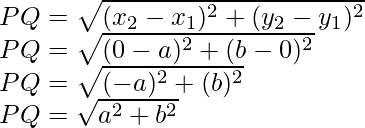
问题2.当点(3,a)和(4,1)之间的距离为√10时,找到a的值。
解决方案:
Given that point P(3, a) and Q(4, 1) and the distance between them is √10
So, we have to find the value of a
So,
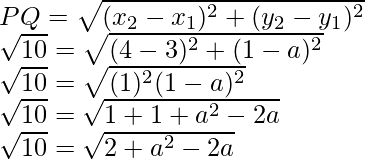
Squaring on both sides we get
(√10)2 = (√{2 + a2 – 2a})2
10 = 2 + a2 – 2a
a2 – 2a + 2 – 10 = 0
a2 – 2a – 8 = 0
On Splitting the middle term we get
a2 – 4a + 2a – 8 = 0
a(a – 4) + 2(a – 4) = 0
(a – 4)(a + 2) = 0
a = 4, a = -2
问题3.如果点(2,1)和(1,2)与点(x,y)等距,则表明x + 3y = 0。
解决方案:
Given that P(2, 1) and Q(1, -2) and R(x, y)
Also, PR = QR
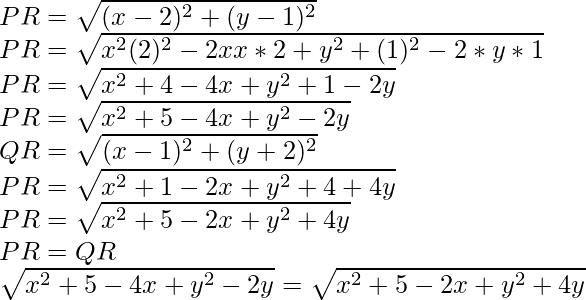
x2 + 5 – 4x + y2 – 2y = x2 + 5 – 2x + y2 + 4y
x2 + 5 – 4x + y2 – 2y = x2 + 5 – 2x + y2 + 4y
-4x + 2x – 2y – 4y = 0
-2x – 6y = 0
-2(x + 3y) = 0
x + 3y = 0/-2
x + 3y = 0
Hence Proved
问题4.如果点(x,y)距(-3,0)以及距(3,0)的距离为4,则求x,y的值。
解决方案:
Given that P(x, y), Q(-3, 0) and R(3, 0).
Also, PQ = PR = 4
So,

On squaring on both sides, we get
(4)2 = (√x2 + 9 + 6x + y2)2
16 = x2 + 9 + 6x + y2
x2 + y2 = 16 – 9 – 6x
x2 + y2 = 7 – 6x ……..(1)

On squaring on both sides, we get
(4)2 = (√x2 + 9 – 6x + y2)2
16 = x2 + 9 – 6x + y2
x2 + y2 = 16 – 9 + 6x
x2 + y2 = 7 + 6x ……..(2)
From equation (1) and (2)
7 – 6x = 7 + 6x
7 – 7 = 6x + 6x
0 = 12x
x = 12
On substituting the value of x = 0 in eq(2)
x2 + y2 = 7 + 6x
0 + y2 = 7 + 6 * 0
y2 = 7
y = ±√7
问题5.线段的长度为10个单位,一个端点的坐标为(2,-3)。如果另一端的横坐标为10,则找到另一端的坐标。
解决方案:
Let the ordinate of other end by y, then The distance between (2, -3) and (10, y) is
 = 10
= 10
Squaring on both sides we get
(8)2 + (y + 3)2 = 100
64 + y2 + 6y + 9 = 100
y2 + 6y + 73 – 100 = 0
y2 + 6y – 27 = 0
y2 + 9y – 3y – 27 = 0
y(y + 9) – 3(y + 9) = 0
(y + 9)(y – 3) = 0
When y + 9 = 0, then y = -9
or when y – 3 = 0, then y = 3
So, the coordinates will be -9 or 3
问题6。证明点(-4,-1),(-2,-4),(4、0)和(2、3)是矩形的顶点。
解决方案:
Let us considered ABCD is a rectangle whose vertices are
A(-4, -1), B(-2, -4), C(4, 0) and D(2, 3)
Now
AB = ![]()
= 
Similarly, CD =√13
AD = √52
and BC = √52
AC = √65 and BD = √65
Here, AB = CD and AD = BC
and diagonals AC = BD
So, ABCD is a rectangle
问题7.证明点A(1,-2),B(3、6),C(5、10)和D(3、2)是平行四边形的顶点。
解决方案:
Given points are A (1, -2), B (3, 6), C (5, 10) and D (3, 2)
Now AB = 
Similarly BC = 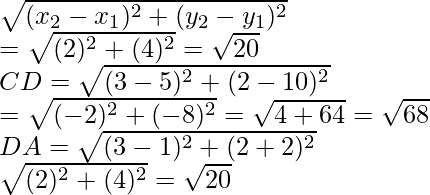
So, from the above we conclude that AB = CD and AD = BC
Hence, ABCD is a parallelogram.
问题8.证明点A(1、7),B(4、2),C(-1,-1)和D(-4、4)是正方形的顶点。
解决方案:
Given points are A (1, 7), B (4, 2), C (-1,-1), D (-4, 4)
If these are the vertices of a square, then its diagonals and sides are equal
AC = 
So, AC = BD
Now AB=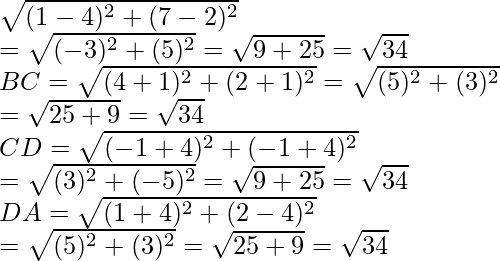
So, AB = BC = CD = DA and diagonal AC = BD
Hence, the given figure ABCD is a square.
问题9证明点(3,0),(6,4)和(-1,3)是直角等腰三角形的顶点。
解决方案:
Given points are A(3, 0), B(6, 4), and C(-1, 3)
Now we find the length of AB = 
Similarly, BC=
From the above we conclude that AB = CA and BC is the longest side
Now we verify the Pythagoras theorem,
So, BC2 = AB2 + CA2
BC2 = (5)2 + (5)2
BC2 = 25 + 25
50 = 50
So, AB2 + CA2 = BC2
Hence, the given triangle ABC is an isosceles right triangle.
问题10.证明(2,-2),(-2、1)和(5,2)是直角三角形的顶点。找出三角形的面积和斜边的长度。
解决方案:
Given points are A(2, -2), B(-2, 1) and C(5, 2)
Now we find the length of 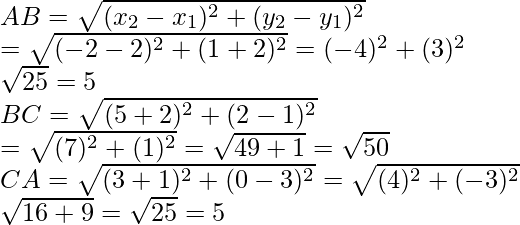
We see that AB = CA and BC is the longest side.
Now we verify the Pythagoras theorem,
So, BC2 = AB2 + CA2
BC2 = (5)2 + (5)2
BC2 = 25 + 25
50 = 50
So, AB2 + CA2 = BC2
So, the given triangle ABC is a right-angled triangle
Now we find the area of triangle ABC = 1/2 × Base × height
= 1/2 × 5 × 5
= 25/2 sq.units
And the length of the hypotenuse BC is √50.
问题11。证明点(2a,4a),(2a,6a)和(2a +√3a,5a)是等边三角形的顶点。
解决方案:
Given points are A(2a, 4a), B(2a, 6a) and C(2a + √3 a, 5a)
Now we find the length of 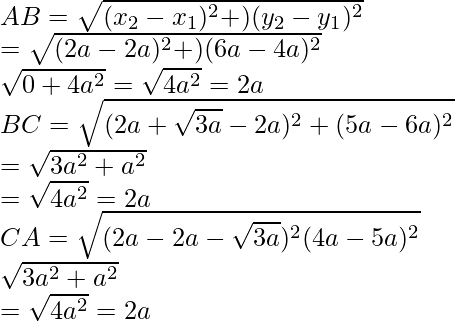
So, we conclude that the length of side AB = BC = CA = 2a
Hence, ∆ABC is equilateral triangle.
问题12.证明点(2、3),(-4,-6)和(1、32)不形成三角形。
Given points are A(2, 3), B(-4, -6), and C(1, 32)
Now we find the length of AB = 
Similarly, for BC = √89 and CA = √2
As we know that the sum of two sides of triangle are always greater than the third side
So, BC + CA= √89 + √2 not greater than AB
Hence, the given points do not form a triangle.
问题13:点A(2,9),B(a,5)和C(5,5)是三角形ABC在B处成直角的顶点。找到a的值,从而找到∆的面积ABC。
解决方案:
Given that, the points A (2, 9), B (a, 5) and C (5, 5) are the vertices of ∆ABC right-angled at B.
By Pythagoras theorem,
AC2 = AB2 + BC2 ………(i)
Now, by distance formula,
We find the length of AB = ![]()
= ]
]
Now put the values of AB, BC and AC in equation(i), we get
![]()
25 = a2 – 4a + 20 + 25 + a2 – 10a
2a2 – 14a + 20 = 0
a2 – 7a + 10 = 0
a2 – 2a – 5a + 10 = 0
a(a – 2) – 5(a – 2) = 0
(a – 5)(a – 5) = 0
a = 2, 5
Here, a ≠ 5, since at a = 5, the length of BC = 0. It is not possible because
the sides AB,BC and CA from a right angled triangle.
So, a = 2
Now, the coordinates are A (2, 9), B (2, 5) and C (5, 5)
Now we find the area of ∆ABC = ![]()
= 1/2[2(5 – 5) + 2(5 – 9) + 5(9 – 5)]
= 1/2(0 – 8 + 20)
= 1/2 × 12
= 6
Hence, the required area of ∆ABC is 6sq. units.
问题14.证明顶点为(2,-1),(3,4),(-2、3)和(-3,-2)的四边形是菱形。
解决方案:
Given points are A(2, -1), B(3, 4), C(-2, 3), and D(-3, -2)
Now we find the length of sides AB, CD, DA, BD and diagonals AC, BD
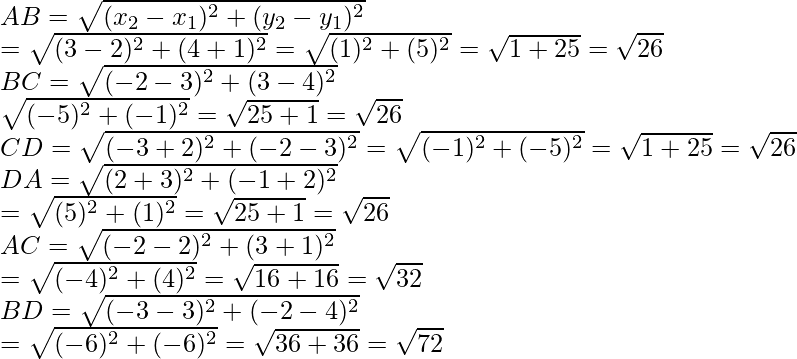
Now we conclude that AB = BC = CD = DA = √26 and diagonal AC ≠ BD
Hence, ABCD is a rhombus
问题15.等腰三角形的两个顶点是(2,0)和(2,5)。如果等边的长度为3,则找到第三个顶点。
解决方案:

Let us considered ABC is an isosceles triangle whose two vertices are A (2, 0) and B (2, 5)
So, the co-ordinates of third vertex C be (x, y)
And also given that AC = BC = 3
Now 
On squaring both sides, we get
(x – 2)2 + y2 = 9
x2 – 4x + 4 + y2 = 9
x2 + y2 – 4x = 5 …….(i)
Similarly, 
On squaring both sides, we get
(x – 2)2 + (y – 5)2 = 9
x2 – 4x + 4 + y2 – 10y + 25 = 9
x2 + y2 – 4x – 10y = -20 …….(ii)
Now on subtracting eq(ii) from (i), we get
10y = 25
y = 25/10 = 5/2
On substituting the value of y in eq(i)
x2 – 4x + (5/2)2 = 5
x2 – 4x + 25/4 – 5 = 0
4x2 – 16x + 25 – 20 = 0
4x2 – 16x + 5 + 5 = 0
Here a = 4, b = -16, c = 5
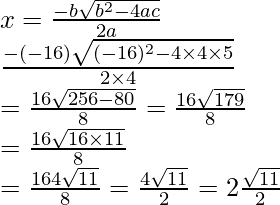
So, the co-ordinate of C will be (2 + √11/2, 5/2) or (2 – √11/2, 5/2)
问题16. x轴上的哪一点与(5,9)和(-4,6)等距?
解决方案:
Let co-ordinates of two points are A (5, 9), B (-4, 6)
The required point is on x-axis
Its ordinates or y-co-ordinates will be 0
Let the co-ordinates of the point C be (x, 0)
AC = CB
Now 
![]()
Squaring both sides, we get
(x – 5)2 + 81 = (x + 4)2 + 36
x2 – 10x + 25 + 81 = x2 + 8x + 16 + 36 – 10x – 8x
-18 = 52 – 106
-18x = -54
x = -54/18
x = 3
Hence, the required point is (3, 0)
问题17.证明点(-2,5),(0,1)和(2,-3)是共线的。
解决方案:
Given points are A(-2, 5), B(0, 1) and C(2, -3)
Now we find the length of AB, BC, and CA
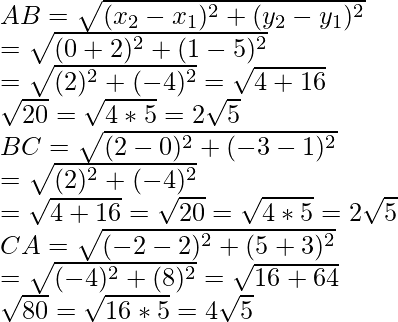
Now AB + BC = 2√5 + 2√5
And CA = 4√5
AB + BC = CA
Hence, A, B and C are collinear
问题18.点P的坐标是(-3,2)。找到位于连接P和原点的线上的点Q的坐标,使得OP = OQ。
解决方案:
Given that the co-ordinates of P are (-3, 2) and origin O are (0, 0)
Let us assume that the co-ordinates of Q be (x, y)
Here, O is the mid-point of line PQ
so by using mid point formula we get,
(x – 3)/2 = 0 and (y + 3)/2 = 0
x = 3, y = -2
Hence, the coordinates of the point Q are (3, -2)
问题19. y轴上的哪一点与(2,3)和(-4,1)等距?
解决方案:
The required point lies on y-axis
Its abscissa will be zero
So, let us assume that the point be C (0, y) and A (2, 3), B (-4, 1)
Now, we find the length of AC and BC

Here, we conclude that AC = BC
So, ![]()
On squaring both sides, we get
4 + (y – 3)2 = 16 + (y – 1)2
4 + y2 + 9 – 6y = 16 + y2 + 1 – 2y
-6y + 2y = 17 – 13
-4y = 4 = y = 4/-4 = 1
Hence, the coordinates of the required point is (0,-1)